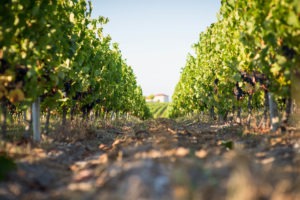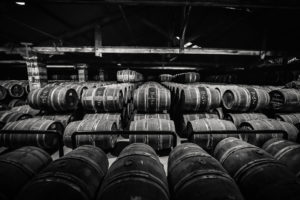PART 2
‘Dear Counsellor, which do you prefer Burgundy or Bordeaux ? ‘ – ‘Madame, replied Brillat Savarin, it is a trial which I enjoy to visit the pièces and I always adjourned within a week the pronunciation of the judgment‘
It’s true that the differences between Bordeaux and Burgundy can be counted on the fingers of one hand. But we must understand them. Also here is the second part of this article where I finally enters the heart of the matter : the taste difference !
•No blending against blending :
Bordeaux is known for its complex wines thanks to the blending. The blending is to ‘mix’ the grapes in a scholarly proportion that varies depending on the properties. The Bordeaux type of grappes are Cabernet Sauvignon, Cabernet Franc and Merlot (there are also other varieties like Petit Verdot and Malbec but to a lesser extent) for the reds and Sauvignon Blanc, Semillon and Muscadelle for white (dry and sweet). As for Burgundy there is no blending and the King grape is Pinot Noir for the reds, Gamay in the Beaujolais region and Chardonnay for white…
Cabernet Sauvignon, Cabernet Franc and Merlot are blended and generally know a barrel aging. Dark ruby color, deep red, often purple… You will find a little bit more of Cabernet Franc on the right bank (Saint-Emilion) : the most incredibly delicious example is Cheval Blanc with 60 % of this variety in its blending. On the left bank there is more Cabernet Sauvignon and Merlot. With notes of black fruits (blackberry, blackcurrant) and red fruits (cherry, strawberry, raspberry), Bordeaux wines are also tannic with well integrated wood accents (normally) on the coconut, vanilla, cocoa and sweet spices. Can appear sometimes an animal side (leather), often beautiful vegetal notes (underbrush, tobacco, mint, pepper) and also subtle floral aromas (violet, rose) : there is a lot of complexity in the Bordeaux wines. All this complexity often creates drift : too much wood, lots of acidity, tannins exacerbated … So pale copies of what may be a quality Bordeaux. Finally, the wines of Bordeaux are recognized as long-keeping wines. Burgundy wines also even if the Pinot Noir is a grape that likes to be drunk Young. For white wines, both dry and sweet wines, Sauvignon Blanc is mostly used with Semillon. The two varieties complement each other perfectly : Sauvignon Blanc provides acidity and freshness while Semillon brings bold flavors such as exotic fruits. White Bordeaux wines are aged in barrels to provide secondary aromas. These are complex wines that can be kept long but are rather consume within five years to enjoy all the vivacity which characterizes them.
In Burgundy, Pinot Noir loves cold climates, so this type of grape is particularly happy in the northern regions of Burgundy (Côte de Nuits, Côte de Beaune and Côte Chalonnaise). It’s also found in Alsace and Champagne, where it developed some potential. You can taste delicious Pinots from warmer climates like Australia or California but the wines will be more jammy. Pinot Noir is a fruity grape pulling cherry, blackberry flavors… It has a great freshness, minerality and often a vegetable side. We consider, and rightly so, that Burgundy is the land of choice for the most beautiful expression of Pinot Noir and also Chardonnay. Chardonnay, great grape of Champagne, provides fresh and fruity wine on green apple, pineapple and smoked with a lovely buttery note. Gamay is used mainly in the Beaujolais region. I will not say what I think of Beaujolais Nouveau or how to raise the fermented grape juice to the rank of festive wine thanks to marketing, but I do not think less ! Still, in Burgundy, there is no blending. The wines are made from a single grape variety and this is what tasters lovers of Burgundy are looking for…. Which brings us to the last point easily : an opposite vision of wine !
• Two opposing visions
The vision of sharing and fun is the same but Burgundy and Bordeaux haven’t the same vision of wine… That’s maybe the biggest difference between these two regions. This is the major point of divergence but how ?
On one side of the ring, you have Bordeaux. Bling bling sometimes, Châteaux are held primarily by large groups of luxury, there are ultra modern cellars equipped or sanitized, Parker and other tasters are shaping the taste of Bordeaux for some years responding to well-oiled marketing strategies and satisfying stressful time of firsts… Anyway, Bordeaux has lost some of its identity but all the properties are not like that, I assure you… And even if that were the case, the major groups have in their hands an inheritage… Cheers made in France and the concept that allows people to dream : the french know-how. We must admit that it’s good… So what are you asking for ? More affordable wines perhaps, a more open minded world and not forgetting where we come from to better know where we’re going ? And all the properties are not affected, I find the same passion for wine in all cellars. The taste of Bordeaux, what is it ? A wine colored, bright red, ruby, garnet red to straw yellow, gold, white topaz. This wine is balanced between fruit and oak. A wine with body, volume, tannins. It’s a drink that makes you hungry and satisfy your thirst. This is a lace taffeta dress, a powerful wine with a complexity specific to each property… The taste of Bordeaux is before everything a taste. Like it or not but we can not deny that the wines are all different, they all have their identity and there are enough to satisfy your curiosity and desire for novelty. The wines can be drunk young, they have a good degree of alcohol (which increases over time, turn around 13.5 / 14 ° for red and is not so far for the white), they also apply to be tasted older if you have the patience to wait between 7 and 10 years. Then drink these wines alone (depending designations anyway) or accompanied : pairings are numerous and rich ! Meats, cheeses, grilled méat over vine shoots, game, chocolate cakes for red (and you understand that it’s a mini mini mini list). Fish, oysters from Bassin d’Arcachon, chicken, foie gras, goat cheese, fruits salad for whites.
Then on the other side of the ring, Burgundy. Ancient wine region like Bordeaux, the winemaker is a farmer, he has dirty hands and the commercial part is a chore for him more than anything. The cellars are confidential, small and sometimes seem frozen in time. There is an atmosphere, one that says that you enter on land steeped in history and the wine flows in its veins. Robert Parker is a person non grata in Dijon in particular, tasters have to behave themselves : no one tells the winemaker how to make wine. Burgundy has got some force… Bordeaux which has always been in opposition to authority is very small face to Burgundy which is straight into its boots in its land… The color of the wine is clear and bright. Red, garnet, red-orange for the older wine, straw yellow, golden for the white. There is a righteousness, no room for frills. Fruit, fruit and fruit flavors are sought. The goal of the winemaker is to make, thanks to innovations and experiences that led him secretly in his cellar, the best fruit, the purest of the grape, the terroir expression. A litle bit like a tea bag : the vine is the tea plant and water is the soil. It infuses, diffuses, to extract maximum flavor. But Burgundy is not tea, eh ? The wines are extremely thin, round, pleasant, without tannins, they slip into your throat. Perfect alone or with an agreement. They have to be drunk as a fresh, fruity young wine but can also be enjoyed in the prime of life. It’s at this time that the soil will develop its magic : each wine is unique even if the grape is the same for everyone.
Those are the two conceptions of wine. On the one hand the power and complexity with Bordeaux, across the roundness and finesse of Burgundy. There’s something for everyone !
Why this war ? You understood that the differences between Bordeaux and Burgundy are diverse. It’s therefore evident that comparing two regions, two designs, two wines is extremely difficult and finally it’s your taste which guides you to your preference. We can not judge the quality of these areas depending on the type of containers, the battle Clos / Château, blending or not…
Personally, I prefer the wines of Bordeaux. Imagine a body : a skeleton with flesh, shapes, colors. The comparison may seem a little strange but when I taste a Bordeaux, there is this structure that represents the skeleton and there is more fruity, woody flavors that bring volume, which is like the flesh. Burgundy represents the purity of variety, more austere, leaner too. But this impression is my business. I appreciate the wines of Burgundy but I prefer Bordeaux wines. It’s not a question of quality, just a question of taste tho !



